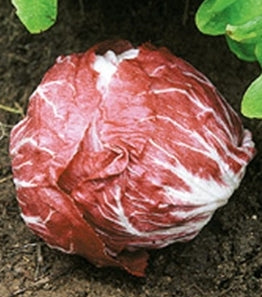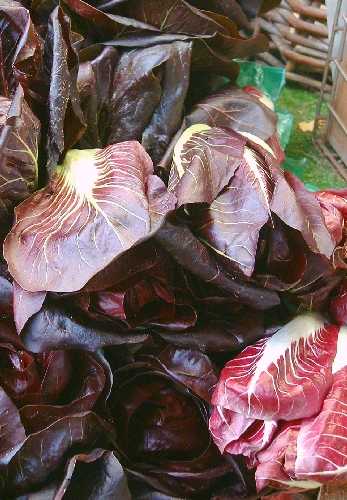How to Grow Chicory, Endive, Escarole, Radicchio & Dandelion

What's the difference & how to use them:
-
Chicory (Cichorium intybus) – There leaf & heart varieties, typically have an assertive, pleasantly bitter flavour; eat young leaves raw in mixed salads or braise mature leaves and hearts. Roots of witloof can be roasted for “coffee.”
-
Endive (Cichorium endivia) – fine leaf, lacy, curly leaves (frisée) or broad leafed varieties with a gentle, peppery bite; perfect raw for crunch or wilted into warm salads.
-
Escarole (Cichorium endivia) – broad, soft green leaves with the mildest bitterness of the group; swap for spinach in soups or sauté with garlic and olive oil.
-
Radicchio (Cichorium intybus) – tight burgundy-and-white heads; robust bittersweet taste that mellows when grilled, roasted or added to risotto.
-
Italian dandelion (Cichorium endivia) – elongated, jagged leaves reminiscent of true dandelion; bright, earthy bitterness that shines in salads, pestos or quickly wilted with lemon.
All belong to Cichorium spp. and share similar cultural needs.
Chicory (leaf and witloof types)
Ave. Seeds per Gram: 500 – 900
Optimal Germination: 15 – 18 °C; germinates in 7 – 10 days
Feed Requirements: light; enrich soil with compost, no heavy fertiliser needed
Growing Notes:
- Sow direct 5 mm deep, 20 cm apart in rows 30 cm apart, from late summer into early autumn.
- Choose full sun, fertile, well-drained soil.
- Fast-maturing leaf types can be sown in early spring, but head-forming witloof and sugar-loaf are best for autumn–winter to avoid bitterness in heat.
- Keep moist for steady growth; water at soil level to deter mildew.
- Mulch after seedlings are establish.
Common Problems & Pests:
- Slow growth or heat leads to extra bitterness;
- Downy mildew and aphids in humid spells;
- Slugs on seedlings.
- Space plants well, provide airflow and use beer traps or night collection for slugs.
Harvesting Notes:
- Loose leaves: pick outer leaves as needed.
- Heads: cut at the base just before tight heart opens.
- For witloof “chicons,” lift roots in late autumn, cut tops to 2 cm, then store upright in a box of damp sand in the dark at 10 – 15 °C; new pale chicons appear in 3 – 4 weeks.
Enjoy the crunchy bitterness—grill halves with balsamic or slice raw for a vibrant salad finish.
Endive (Frisée)
Ave. Seeds per Gram: 500 – 900
Optimal Germination: 15 – 18 °C; germinates in 7 – 10 days
Feed Requirements: light; compost in planting bed is plenty
Growing Notes:
- Sow direct or raise seedlings and transplant at 20–30 cm spacing;
- Avoid sowing seed in midsummer heat or deep winter frost.
- Endive tolerates cool but not extremes; frosts sweeten flavour.
- Keep soil moist;
- To soften flavour, blanch hearts two weeks before harvest by tying outer leaves or placing an up-turned pot over plants.
Common Problems & Pests:
- Bolting in sudden heat or cold snaps;
- Bitter leaves from slow growth;
- Slugs and snails.
- Provide steady water, harvest promptly, and use slug controls.
Harvesting Notes:
- Pick outer leaves for extended supply or cut whole head at soil line.
- Refrigerate in a perforated bag for up to a week.
Crunchy frisée adds loft and snap to winter salads—pair with citrus segments or poach an egg on top.
Escarole
Ave. Seeds per Gram: 500 – 900
Optimal Germination: 15 – 18 °C; germinates in 7 – 10 days
Feed Requirements: light; compost-rich soil is enough
Growing Notes:
- Sow 1 cm deep in rows 30-45 cm apart from late summer into early autumn;
- Thin seedlings to 30–45 cm.
- Escarole prefers the same cool conditions as lettuce but is more tolerant of frost.
- Water consistently to keep leaves tender.
Common Problems & Pests:
- Over-wintered heads can rot in very wet climates—plant in raised beds or protect with cloches.
- Slugs love the broad leaves.
Harvesting Notes:
- Harvest outer leaves as needed or cut entire hearts when firm and full. Before spring warmth triggers seed-stalks, pull remaining plants.
Mildly bitter escarole is classic in Italian bean soup or simply grilled with olive oil.
Radicchio
Ave. Seeds per Gram: 500 – 900
Optimal Germination: 15 – 18 °C; germinates in 7 – 10 days
Feed Requirements: light; compost and regular moisture suffice
Growing Notes:
- Sow or transplant 1 cm deep, 30 cm apart, from late summer so heads mature in cool autumn weather;
- Spring sowings bolt and taste harsh.
- Growth is slow—expect 90 – 100 days to tight, wine-red heads.
- Water regularly; irregular watering intensifies bitterness.
Common Problems & Pests:
- Heads fail to form in warm spells or if plants are crowded.
- Aphids cluster in folds; spray off with a sharp water blast.
Harvesting Notes:
- Cut heads at soil line when firm.
- Store unwashed in the crisper for up to two weeks.
- Leaves lose colour when cooked but gain sweetness—try quartered and roasted until caramelised.
Radicchio’s vibrant hue and bittersweet bite elevate salads, pizzas and risottos.
Italian Dandelion (Cichorium intybus var. foliosum)
Ave. Seeds per Gram: 500 – 900
Optimal Germination: 15 – 18 °C; germinates in 7 – 10 days
Feed Requirements: light; moderate compost only
Growing Notes:
- This chicory thrives year-round.
- Direct-sow 5 mm deep, thinning to 8–10 cm for baby-leaf or 20 cm for mature plants.
- Full sun to part shade; steady watering promotes lush growth.
Common Problems & Pests:
- Part of the beauty of dandelions is that they are relatively trouble-free and provide greens all year;
- Primary issues are slugs on tender seedlings and excessive bitterness from irregular watering;
- Mulch and water evenly.
Harvesting Notes:
- Begin cutting young leaves once plants look robust enough to handle a small harvest, they resprout for continuous harvest.
- Older leaves braise well, while slender stems add crunch to stir-fries.
- Roots can be lifted and roasted like parsnip.
Italian dandelion delivers bold flavour plus calcium and iron—toss raw with orange and shaved fennel for a spring tonic.
Enjoy cultivating this versatile chicory clan—cool-season colour, complex flavours and hearty nutrition, all from an easy, low-input crop.
Sowing Periods
| J | F | M | A | M | J | J | A | S | O | N | D | |
|---|---|---|---|---|---|---|---|---|---|---|---|---|
| Cool | ||||||||||||
| Temperate | ||||||||||||
| Sub-Tropical/Tropical |
Filters
3 products



